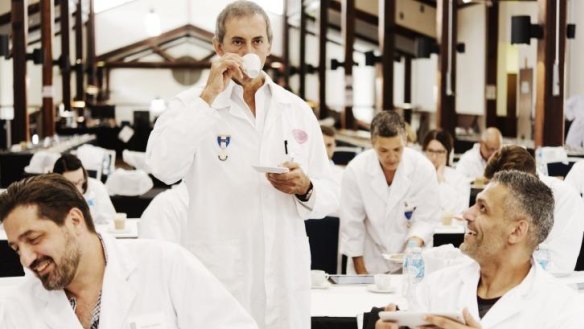Finding the best coffee before Sydney Royal Easter Show opens

It sounds like a dream job for any coffee-crazy-caffeine hound until you actually do it: Taste 70 lattes over a two-day period.
Armed with a bucket to spit after the first taste, 27 industry judges from around Australia are in the process of sampling more than 1600 cups of coffee to choose the winners of this year's Sydney Royal Coffee Competition. The winners of gold, silver and bronze will be displayed at the Sydney Royal Easter Show, opening mid-March.
Joseph Gadallah, the head of roasting with Allpress Espresso, spent Thursday morning judging espressos, his choice of coffee. He'd given a bronze to a "completely surprising" and "absolutely beautiful" decaffeinated espresso – which was competing against caffeinated brews.
Another decaf had been so bad he hadn't wanted to score it.
"The roast was completely wrong; the flavour was like sucking on a lemon," said Mr Gadallah who decided to follow his "passion" for coffee and switch from a career in computer science about 10 years ago.
To reduce palate fatigue – an increasing problem given the record number of entries this year – the judges are given a break after tasting six coffees. They're also provided with a plate of snacks. Often the flavour lingers long after the coffee, a plus with a good coffee and a nasty memory with others we tasted.
Mr Gadallah took the mega dose of caffeine in his stride. "Your tolerance builds up," he said, adding that he once retired for a nap after 40 espressos at one industry show.
For the first time this year, the judges are using the record 302 entries of coffee beans to make plunger coffee, espressos and lattes,which replace cappuccinos for the first time. The shift represents the increasing popularity of lattes – described by the chair of judges Paul Mannassis as a coffee with milk folded in with a nice creamy foam on top and served in a glass cup. Other judges suggested the difference between a latte and the Australian favourite, the flat white, was small.
A bank of professional baristas turned out uniform lattes, with the required decorative swirl in the milk. Yet the judges were looking for the best beans – from their appearance to their aroma and the final product – and not how each coffee was made.
Australians had one of the most sophisticated coffee cultures in the world, said Mr Mannassis. Only beans that were roasted or grown in Australia – and were available on a commercial basis – were eligible for entry into the show.
Asked about the trend to artisanal coffee houses, Mr Mannassis, who owns Mocha Coffee in Marrickville NSW, said the average person wanted a good coffee at a reasonable price.
"They are all great, but if you follow the general public in cafes, where they are offering five different origins, cold drip and all, people just want a cup of coffee.
"They will just walk in, say they want their latte, turn their back and read their paper, get their coffee and go off to work. We've improved a lot, we're scientific, there is an art, but a lot of people want an average fair cup of coffee that should taste right, and I think they're on a winner if that happens."
See results next week at Sydney Royal Fine Food or at the Easter Show.
